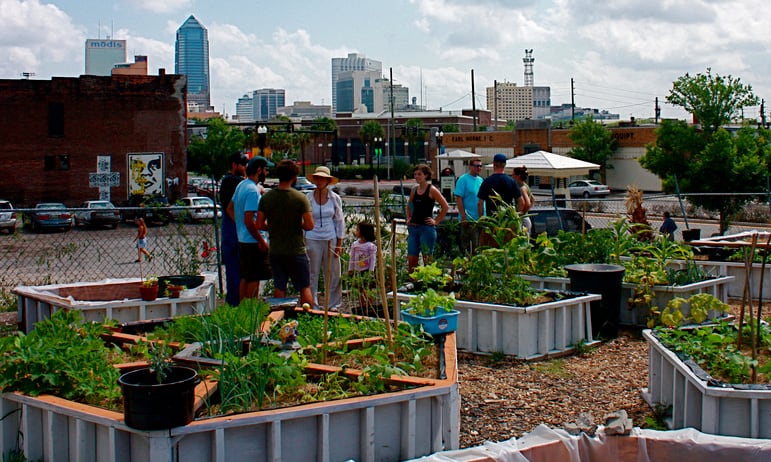The Main Principles Of City Blooming
Wiki Article
The Greatest Guide To City Blooming
Table of ContentsThe Best Strategy To Use For City BloomingThe 30-Second Trick For City BloomingCity Blooming Fundamentals ExplainedUnknown Facts About City BloomingThe smart Trick of City Blooming That Nobody is Discussing
Fascinated in growing food available in the City of Chicago? Thinking of starting a neighborhood garden? Changes to the Chicago Zoning Statute permit agricultural usages like community yards and metropolitan farms in several parts of the city. Below is a listing of often asked concerns relating to the regulations and regulations that growers must consider when planning a city agriculture project.
The zoning amendment does not customize any kind of other codes handling composting, structure permits, acquiring or renting City possessed home, company licenses or ecological contamination. There are existing codes that control these problems and they remain completely impact and may apply to your project. Area gardens are typically possessed or handled by public entities, public organizations or community-based organizations and maintained by volunteers.
Urban ranches grow food that is planned to be sold, either on a not-for-profit or for-profit basis. Due to their business purpose, city farms call for a service certificate.
Little Known Questions About City Blooming.
Composting is enabled but only for plant product that is generated and utilized on website. The amount of garden compost product can not exceed 25 cubic lawns at any type of given time according to the standards in 7-28-715 of the City's Municipal Code. Yes. Because the soil at most new yard websites needs amending, compost, dirt, timber chips, or other materials can be obtained to build or enhance the expanding area - landscaping.
If a structure license is required then the hoophouse will be considered an accessory structure. You can find out even more about the building authorization demands by calling the Division of Structures. The 25,000-square-foot dimension restriction is intended to protect against a solitary area garden from dominating a provided block or interfering with the block's existing residential or business character.
The restriction does not use to yards found in Public Open Area (POS) districts. Can there be even more than one neighborhood garden that is 25,000 square feet on a single block? Secure fencing is not required, however, gardens that have large parking areas may be needed to set up fencing or other landscape design functions.
A Biased View of City Blooming
B1 & B2 districts call for that all industrial use activities be conducted indoors. R districts limit commercial task. The laws mirror the objective and intent of the Zoning Code. Is fencing required for city ranches? Yes. Fences might be required, along with landscaping and screening, for particular auto parking locations and outdoor job or storage locations depending on location and the details task happening.Yes. Urban farms call for structure permits and zoning approvals prior to building and construction. Other forms of city review may be needed depending upon details structures, tasks, size, landscape design, licensing, public health and stormwater management issues. Most of these requirements are determined in the task design or allowing procedure, nevertheless, the candidate may be responsible to separately recognize certain licenses or allows that may be needed.
Yes. The sort of certificate is identified by what is happening at the website. The Division of Business Matters and Consumer Protection can aid determine the certain kind of organization permit that's called for. Yes. Off street parking is required for many commercial tasks in Chicago. The needed number of parking areas is based on the variety of employees working with website and not the square video footage of the growing room.
The Buzz on City Blooming

An urban farm can market compost product created on site, however, the procedure needs to abide with the laws in 7-28-715 of the Chicago Municipal Code. Aquaponic systems are allowed inside your home on city ranches in several zoning areas.
Approximately 5 hives or colonies of honey might be kept as an accessory usage. Beekeepers need to register with the Illinois Department of Agriculture. For additional information about the proposed zoning modification you may call the Department of Real Estate and Economic Advancement, Bureau of Planning and Zoning at 312.744.8563.
Farming in cities and you could look here metropolitan areas A metropolitan ranch in Chicago. Urban agriculture refers to different techniques of cultivating. https://worldcosplay.net/member/1784867, handling, and distributing food in city areas. The term additionally uses to the location tasks of pet husbandry, aquaculture, beekeeping, and horticulture in a city context. Urban agriculture is differentiated from peri-urban agriculture, which takes place in backwoods at the edge of suburbs.
The Best Guide To City Blooming
It can entail a motion of natural farmers, "foodies" and "locavores", who seek to develop social networks based on a common principles of nature and area holism. These networks can create using formal institutional assistance, coming to be integrated into regional town planning as a "shift town" activity for lasting metropolitan advancement.Some of the very first evidence of city farming comes from Mesopotamia.
Report this wiki page